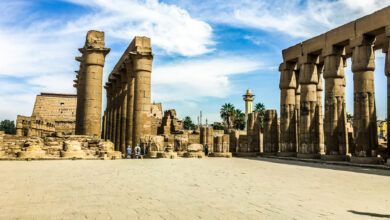Bearing the name of the first Fatimid Caliph ruling Egypt, Al-Moez Leddine Allah al-Fatimy, and founded in 969 AD, Moez Street is the oldest main street of the Fatimid capital Cairo. Three years ago a massive restoration project of the street was completed, but it has recently begun to fall into disrepair.
The Hakim mosque, the complex of Al-Nasser Mohamed Ibn Qalawon, the Barqouq complex and Wekalet Al-Rab'a are some of the most famous monuments on Moez Street, from the Fatimid period (969-1171 AD) all the way through the Ottoman period (1517-1805 AD). These monuments also present the diverse Cairene architectural styles at the time, from mosques, houses, and schools to sabils (public water fountains for drinking, installed as memorials for people).
Aside from its archaeological and historical uniqueness, Moez offers a lively narrative of the social history of the inhabitants of Hussein, one of the most densely populated districts of Cairo. Still, the street and its monuments have suffered from government negligence for decades. It was only in the 1990s that a huge restoration plan for the street was drawn up.
"Have you visited Moez Street recently? Have you seen how amazing it's become?" was a question people repeated three years ago.
The immense project was undertaken by the Culture and Housing ministries and Cairo Governorate in several stages between 1998 and 2008. It cost LE35 million and included restoring about 200 monuments and turning the street into a pedestrian area with a stone thoroughfare.
With impressive lighting designed by the Egyptian Sound, Light and Cinema Company to highlight its beautiful architecture, Moez Street offered visitors and locals one of Cairo's most pleasant historical tours. Yet now this peaceful experience has been lost.
"Last June, I was walking with a friend on Moez Street, and we struggled to escape the cars and motorbikes driving through. A number of cafes also set up shop on the sidewalks leading to Beit al-Seheimi and the Hakim mosque," says Basma Ashour, a freelance photographer who has been teaching photography classes at Moez since 2010.
In the absence of any government efforts to bring law and order back to the street, Ashour started an awareness campaign on Facebook in July, asking people to save the historic area.
"The current status of the street is devastating, to the extent that monuments could easily be damaged,” she says.
In three months almost 2000 people have joined the Facebook group. Organizers of the campaign have been able to attract the attention of the media, and later the Supreme Council of Antiquities as well as Cairo Governorate's government.
In mid-August, police forces reappeared on the street and removed the cafe tables. They began restricting the access of cars to the street, but only for two hours in the afternoon. This was celebrated in the media as a successful police operation.
"Although the police were successful in removing many of the threats by the end of Ramadan, Moez still needs more attention from the government," says Ashour.
Last week Moez was still full of cars and motorbikes, and tourists were nowhere to be seen. Local shop owners complained that the street's decline has badly affected their sales. "We really hope the police will come back soon to keep cars out, and refresh our economic activity, which is strongly linked to a peaceful walking experience," says an antique shop owner at Moez who prefers to remain anonymous.
"Although I am a bit disappointed, for the moment, because of the weak government response to the issue, I will continue with the campaign. Much effort is needed to increase public awareness about the preservation of our heritage,” says Ashour.
As for the Supreme Council of Antiquities, press statements made by its officials confirm the limited impact the council can have on Moez Street while police presence remains limited.
"In cooperation with the antiquities police, we are now working on putting back several police kiosks along the street to tackle the issue very soon," says Mostafa Amin, head of the Sector of Islamic and Coptic Antiquities at the council. “This is a long-term plan that will also include installing electronic gates that prevent cars from driving through.”
Photos by Basma Ashour




